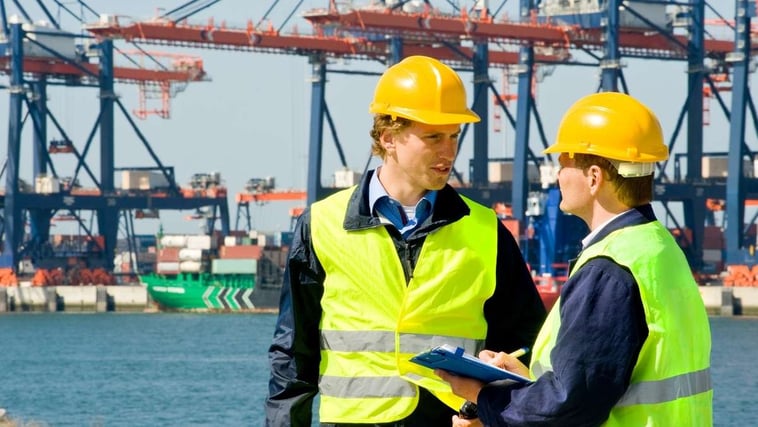Reefer productivity: Why automate your operations?
| Written by Mark Buzinkay
With insurance claim costs, accidents, and terminal slowdowns, your reefer productivity will suffer but also trust and future business can linger for years.
Automatic reefer monitoring and management is a proven solution protecting your and your customer's assets.

No video selected
Select a video type in the sidebar.
"By automating reefer monitoring, you not only reduce human error but also gain real-time insights that keep your operations running smoothly and efficiently."
Jordi Asensio, Product Manager Reefer Runner
Resources are limited - in the industry, the global supply chain, and container terminals - and, therefore, are valuable. Money, time, workforce, and market access are just a few examples of scarce input factors that you need for proper business processes.
Productivity is commonly defined as a ratio between the output volume and the volume of inputs. In other words, it measures how efficiently production inputs, such as labour and capital, are used in an economy to produce a given output.
Therefore, terminal productivity includes several measurements of productivity to calculate - for example, regarding maintaining the ship's planned schedule, the productivity should cover end to end port operation process, which is from arrival for pickup pilot until departure after completion of cargo operation. This includes the total handling volume, the number of personnel, and crane and equipment productivity.
As the pressure in the global supply chain increases and container terminals are the vital gateways for the global economies, terminal productivity becomes focused on providing reliability and stability to the supply chain and improving their output considerably. As a result, productivity is in focus once more and more than ever.
What are the REEFER PRODUCTIVITY FACTORS?
One specific part of a container terminal yard is reserved for refrigerated containers. Reefers protect temperature-sensitive cargo in isolated and cooled containers. These reefers feature gen-sets which keep the inside of the container at a defined temperature, sometimes low as -30 degrees Celcius or even less. The power to run a genset comes from a reefer plug. Therefore, reefers have a dedicated section within the yard which can not be expanded endlessly. Thus, the amount of reefer plugs determines the maximum reefer capacity of a port.
Besides capacity and energy consumption, the other crucial operational factor is the workforce. Reefers protect cargo by keeping it within the defined and product-specific temperature range. A reefer can maintain a temperature only for a limited time without active cooling powered by a genset. Therefore, dockers must observe the temperature inside the reefer regularly and check if power is available before a dangerous temperature peak affects cargo. Typically, a worker checks temperature and power every six hours, day and night, all week long.
Spoiled cargo is a massive headache for everyone involved - the owners of the cargo, the shipper, and the container terminal operator. Reefer cargo claims typically range between $5,000 and $3,000,000 per incident. The average claim cost over five years was approximately $38,000, after deductibles. (1) Spoiled cargo is often discovered when the reefer door is opened at the end of the supply chain: at the customer's warehouse. In the case of bad goods, someone will pay for the damage. For this reason, documentation of the temperatures inside the reefer during the journey is essential. From a container terminal point of view, monitoring and managing joints go hand in hand with documenting the entire process for every reefer. However, this work can be combined with the worker's regular local checks at the reefer. A worker records the ID of the reefer, the time and the temperature inside for possible claim handling.
An additional aspect of manual handling is plugging and unplugging a reefer. When a reefer arrives at the port, it will be transferred from a vessel to its temporary position. Reefer racks provide space up to 4 reefers high, equipped with convenient stairs and gangways for workers to plug and unplug them and for their regular checks. Several racks can form a block, and the size of a block is typically determined by the cranes and equipment you want to use to move containers.
All these factors -space, energy, workforce, processes, spoiled cargo, and container handling equipment- will directly influence your reefer productivity.

How does Automation impact REEFER PRODUCTIVITY?
One established and industry-proven approach to increasing productivity is the automation of processes. Automation of processes includes standardization of assets and process steps, an infrastructure enabling automated asset handling, real-time data and software to simultaneously manage process steps for many assets.
Regarding refrigerated containers, automation offers higher productivity in several aspects:
Insurance claims
As mentioned above, handling insurance claims is work-intensive and costly. The damaged cargo of one reefer alone can be worth millions of Euro (in the case of pharmaceuticals). What's important to understand is that a high percentage of all refrigerated transport insurance claims are due to the miscommunication of operational instructions, temperature setting errors, and reefer equipment mechanical failures. This said, many claims are not at the fault of the container terminal and could be rejected based on proper documentation. On the other hand, technical breakdowns and human errors when operating a reefer can happen.
Automation can help here twice: (1) Recording the temperature and power constantly and safely, creating automated documentation and proof; and (2) alarming the control room if something is wrong with the reefer, for instance, loss of power or exceeding a set temperature.
Human errors
Plugging, setting up a reefer, and unplugging many times a day, including regular walks from reefer to reefer to check temperature and energy, in every weather condition, is tedious work. Visibility may be low, it can be noisy, and tasks must be performed under stress. Human errors happen, but automation could mitigate the risks of monotonous work. For instance, the terminal operating software could compare the temperature recommended by the cargo owner with the current temperature settings and, if necessary, correct them.
Personnel safety
No one wants to have an accident, especially one involving human injury. And today's fast-paced port environments require workers to maintain precise attention and care for safety while working. Yet, unlike dry containers, refrigerated containers require more human interaction. Therefore, regardless of weather conditions, routine inspections and data collection are essential to ensuring each reefer is operational and maintains the proper settings, a practice that increases the possibility of personal risk.
An automated system for remotely recording reefer data and managing set-points and other variables reduces pedestrian traffic in the container yard, improving human safety.
Terminal equipment
Automated terminals strive for high productivity. But as safety is always the priority, container handling equipment will halt operations when humans are nearby. Dockers will interfere with this type of equipment every time they enter the container yard, and for security reasons, they have to stop. Every little stop of a few minutes will accumulate to hours of idle time per day, reducing the productivity of terminal equipment. Therefore, it is a good idea to automate as many process steps in the yard as possible to keep workers safe and not disrupt the work of container handling equipment (Further reading: Automated reefer logistics in ports).

FAQ
What KPIs Every Terminal Should Track?
To achieve optimal performance of the cooling operation, several key performance indicators (KPIs) must be monitored to track productivity. They show areas for improvement and the performance of measures taken.
Temperature Compliance Rate
This critical metric tracks how well the correct temperatures are maintained. A high compliance rate indicates effective monitoring and control systems.
Energy Consumption
A significant proportion of a container terminal's energy costs are spent operating the reefer plugs. By tracking energy consumption, terminals can assess how well the cooling units function and whether measures to reduce energy consumption are working.
Downtime
Minimising downtime as much as possible is crucial to maintaining productivity. This value measures the total hours a reefer is unavailable due to maintenance or malfunctions. A lower downtime rate indicates a more efficient fleet and better overall system reliability.
Turnaround Time
The faster a reefer leaves the port, the more efficient the operation is - just like a dry container. This KPI measures the time the reefer spends in port and helps identify bottlenecks in the process that could slow down operations.
Cargo Loss Rate
This tracks the amount of cargo (and its cost) that is lost, damaged or spoiled due to issues such as temperature fluctuations or equipment malfunctions. The higher the rate, the more inefficient the management process; the lower the rate, the more efficient the monitoring and control systems are. By monitoring this KPI, terminals can identify areas where temperature consistency, equipment reliability and overall cargo handling can be improved.
TAKEAWAY
Insurance claim costs, accidents, and terminal slowdowns are not only financial. Loss of trust and future business can linger for years. Automatic reefer monitoring and management protects your and your customer's assets. Automated alerting, centralized remote control of set-points and power management, and avoiding human errors will increase the productivity of your reefer operations. Follow up with two examples: Reefer operation at Puerto Bolivar and reefer operations at OPCSA.
In addition, automation creates data that is powerful for stakeholders in your terminal operation. Accurately incorporating data from the reefer operation into terminal-wide decision-making improves overall performance and enhances the bottom line. Automated reefer monitoring systems that integrate with your existing Terminal Operating System (TOS) make this data collaboration easy.
Delve deeper into one of our core topics: Refrigerated containers
Glossary
Downtime refers to periods when the reefer container is non-operational due to equipment failure, maintenance issues, or power outages. Downtime can disrupt temperature control, leading to cargo spoilage and financial losses. Common causes include compressor malfunctions, electrical faults, or clogged vents. Preventive maintenance, routine inspections, and prompt repairs are essential to minimize downtime and ensure optimal performance during transit. (2)
A shipper (or consignor) is the individual or company responsible for preparing and dispatching goods. They ensure proper packaging, labeling, and documentation, such as the bill of lading, to comply with transport and customs regulations. The shipper coordinates with carriers for efficient movement of cargo and may own containers (Shipper Owned Containers) for greater control over logistics. Their role is pivotal in initiating and managing the supply chain process. (3)
References:
(1) https://www.swedishclub.com/uploads/2023/12/TSC_Container_focus_Reefers_2022_WEB.pdf
(2) Kerbel, E. (2022): Refrigerated Transportation in Marine Containers. Routledge.
(3) Levinson, M. (2016): The Box: How the Shipping Container Made the World Smaller and the World Economy Bigger. Princeton University Press.
Note: This article was updated on the 9th of April 2025

Author
Mark Buzinkay, Head of Marketing
Mark Buzinkay holds a PhD in Virtual Anthropology, a Master in Business Administration (Telecommunications Mgmt), a Master of Science in Information Management and a Master of Arts in History, Sociology and Philosophy. Mark spent most of his professional career developing and creating business ideas - from a marketing, organisational and process point of view. He is fascinated by the digital transformation of industries, especially manufacturing and logistics. Mark writes mainly about Industry 4.0, maritime logistics, process and change management, innovations onshore and offshore, and the digital transformation in general.
Related Articles
Related Product





